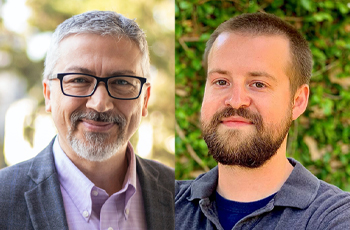New Lattimer Research Fellows Announced
February 17, 2021 | By Mario Aguilera
UC San Diego’s Division of Physical Sciences is proud to announce that Massimiliano Di Ventra (Department of Physics) and Mark Herzik (Department of Chemistry and Biochemistry) have been awarded 2021-2022 George W. and Carol A. Lattimer Faculty Research Fellowships.
Lattimer Fellowships are designed as a generative tool, effectively seeding innovation, entrepreneurial spirit and cross-disciplinary initiatives. The fellowships recognize that intellectual integration essentially forged UC San Diego’s reputation, with faculty from across campus having built an extraordinary network for interdisciplinary research and training. This award provides for the continuation of this momentum for generating new ideas and research areas.
 Massimiliano Di Ventra and Mark Herzik
Massimiliano Di Ventra and Mark Herzik
Di Ventra’s research interests include the theory of quantum transport in nanoscale and atomic systems, non-equilibrium statistical mechanics, DNA sequencing/polymer dynamics in nanopores and memory effects in nanostructures for applications in unconventional computing and biophysics. Learning and adaptation are fundamental features of biological organisms that allow them to respond to a continuously varying environment. But how these phenomena emerge in complex systems is still not fully understood. During his Lattimer Fellowship, “Learning, Adaptation, and the Brain Topology,” Di Ventra will seek to understand the physical basis of such features, and how they relate to the brain topology/architecture.
Herzik’s research focuses on the molecular mechanisms that govern macromolecular transport within eukaryotic cells. His lab employs innovative cryo-EM methodologies to provide an atomic-level understanding of the structure and dynamics that govern these complex biological processes. His Lattimer Fellowship, “4-Dimensional Visualization of Mitochondrial Dynamics by Light and Electron Microscopies,” will aim provide insights into these fundamental questions. In a collaborative project, Herzik will seek to expand the current structural toolkit to incorporate lattice-light sheet microscopy (LLSM)—a powerful new technique that allows for the high-resolution visualization of native biological components in four-dimensions—to complement high-resolution cryo-EM structural studies.
